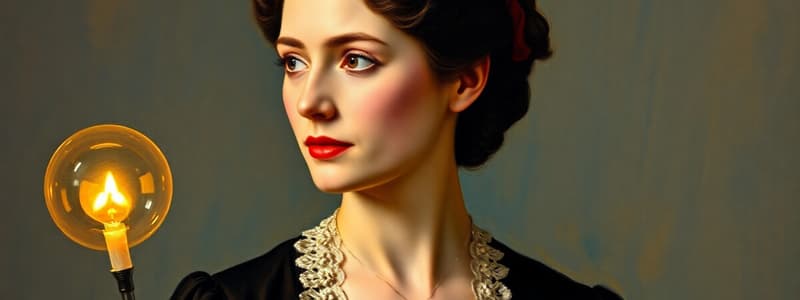Podcast
Questions and Answers
What crucial contribution did Marie Curie make to the field of radioactivity in 1910?
What crucial contribution did Marie Curie make to the field of radioactivity in 1910?
- Discovered the phenomenon of radioactivity.
- Developed the first Geiger counter.
- Invented the X-ray machine.
- Successfully isolated pure radium. (correct)
For what specific achievement did Marie Curie receive the Nobel Prize in Chemistry in 1911?
For what specific achievement did Marie Curie receive the Nobel Prize in Chemistry in 1911?
- Sharing X-ray technology and usage
- Developing the theory of radioactivity.
- Isolating and characterizing radium. (correct)
- Discovering the element uranium.
- Inventing the mobile X-ray unit.
Who is credited with the initial discovery of natural radioactivity?
Who is credited with the initial discovery of natural radioactivity?
- Pierre Curie
- Antoine Henri Becquerel (correct)
- Irène Joliot-Curie
- Marie Curie
What term did Marie Curie introduce to describe the emission of energy from disintegrating atoms?
What term did Marie Curie introduce to describe the emission of energy from disintegrating atoms?
How did Marie Curie primarily fund the creation of mobile X-ray units during World War I?
How did Marie Curie primarily fund the creation of mobile X-ray units during World War I?
What innovative medical application did Marie Curie pioneer using radium?
What innovative medical application did Marie Curie pioneer using radium?
What was the approximate cost of one gram of radium in 1921?
What was the approximate cost of one gram of radium in 1921?
In what year did Marie Curie meet her future husband, Pierre Curie?
In what year did Marie Curie meet her future husband, Pierre Curie?
What specific health issue led to Marie Curie's death?
What specific health issue led to Marie Curie's death?
Which inherent characteristic of radioactive substances makes them dangerous?
Which inherent characteristic of radioactive substances makes them dangerous?
Flashcards
Antoine Henri Becquerel
Antoine Henri Becquerel
Discovered natural radioactivity in 1896 and identified uranium's radiation.
Radioactivity
Radioactivity
Release of energy when atoms disintegrate, coined by Marie Curie.
Nobel Prize in Chemistry
Nobel Prize in Chemistry
Awarded to Marie Curie in 1911 for her work on radium.
Mobile X-ray units
Mobile X-ray units
Signup and view all the flashcards
Curie Foundation
Curie Foundation
Signup and view all the flashcards
Radium
Radium
Signup and view all the flashcards
Penetrating power
Penetrating power
Signup and view all the flashcards
Aplastic anemia
Aplastic anemia
Signup and view all the flashcards
Pierre Curie
Pierre Curie
Signup and view all the flashcards
Becquerel
Becquerel
Signup and view all the flashcards
Study Notes
Marie Curie: Pioneer of Radioactivity
- Henri Becquerel discovered natural radioactivity in 1896, observing uranium emitting radioactive particles.
- Marie Curie, following this discovery, isolated pure radium in 1910, winning a Nobel Prize in chemistry for this work in 1911.
- She coined the term "radioactivity" describing energy release from atom disintegration.
- Curie was unaware of the dangers of radioactive substances, handling samples and storing them, leading to radiation sickness.
Curie's Contributions During World War I
- Curie used her Nobel Prize money to create mobile X-ray units ("Petites Curies") for wounded soldiers in World War 1.
- Curie and her daughter, Irène, assisted in treating the wounded using X-rays
- Curie established the Curie Foundation, pioneering cancer research using radium.
Dangers of Radioactivity
- Marie Curie's work on radioactivity, while groundbreaking, led to her developing radiation sickness.
- Prolonged exposure to radiation ultimately caused her death at age 66 from aplastic anemia.
- The medical dangers of too much radiation were highlighted during her research.
Cost of Radium
- One gram of radium cost $100,000 in 1921.
Studying That Suits You
Use AI to generate personalized quizzes and flashcards to suit your learning preferences.





